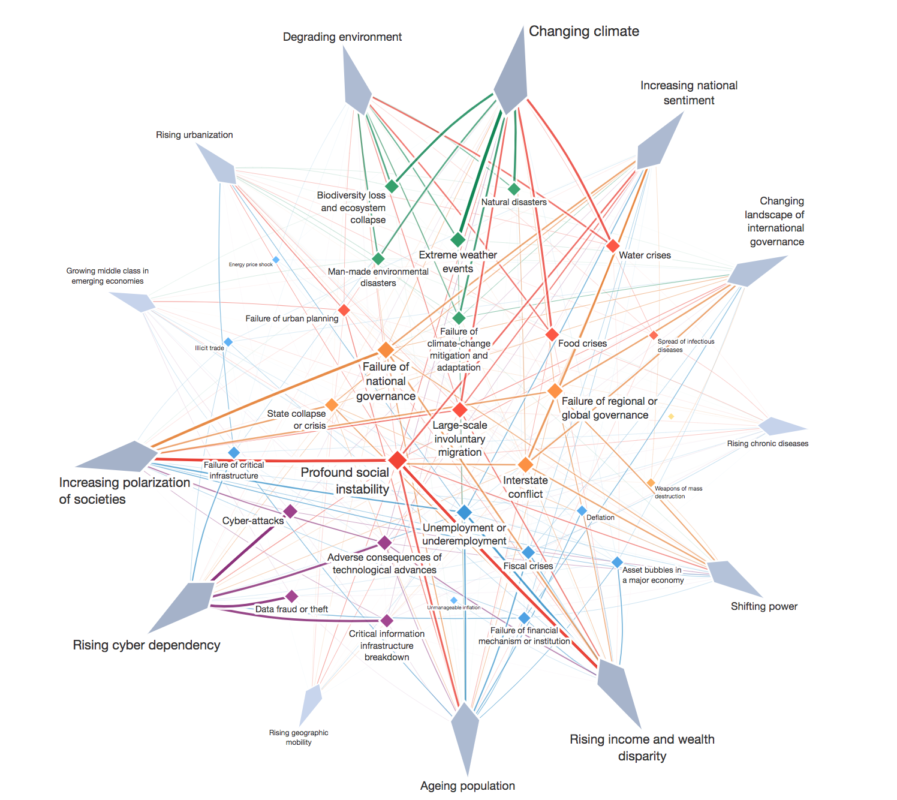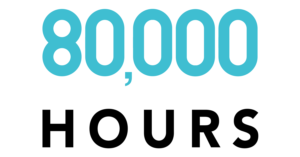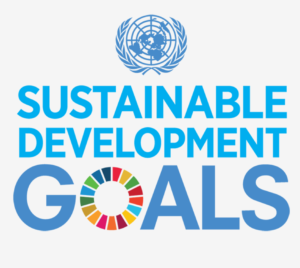Our World’s Biggest Challenges: What Can We Do?
Overview Sections
What Are the Biggest Challenges?
 The World Economic Forum:
The World Economic Forum:
The World Economic Forum is the International Organization for Public-Private Cooperation.The Forum engages the foremost political, business and other leaders of society to shape global, regional and industry agendas. Established in 1971 as a not-for-profit foundation and is headquartered in Geneva, Switzerland, it is independent, impartial and not tied to any special interests. The Forum strives in all its efforts to demonstrate entrepreneurship in the global public interest while upholding the highest standards of governance.
The Global Risk Report: (2019)
The Global Risk Report is produced each year by the WEF. The report presents the results of the Global Risks Perception Survey, in which nearly 1,000 decision-makers from the public sector, private sector, academia and civil society assess the risks facing the world.
Click on the image for an interactive version on the WEF website
If you like the above chart, then you should definitely check out the World Economic Forum’s Strategic Intelligence platform. With it’s ‘Transformation maps’, it highlights the interconnections between issues, helping to better understand issues’ context, and their interconnected nature.
The Global Risks Landscape 2019:
Other Relevant World Economic Forum Survey’s:
The World Economic Forum’s List of Top 10 Global Issues (2016):
The World Economic Forum Global Shapers Survey (2017):
World Economic Forum: Global Risks of Highest Concern For Doing Business (2019)
How Can you Get involved?
 80,000 Hours:
80,000 Hours:
80,000 Hours aims to solve the most pressing skill bottlenecks in the world’s most pressing challenges. They do this by providing research and support to help people switch into careers that effectively tackle these challenges. With this objective, they created a framework for evaluating global to quantitatively evaluate global challenges. It considers the problem’s scale, how neglected it is, and it’s solvability.
If the above chart doesn’t load properly, simply refresh the page 🙂
Links to more detail on each Global Challenge:
 United Nations’ Sustainability Development Goals:
United Nations’ Sustainability Development Goals:
How Can you get involved?

The Millenium Project:
The Millennium Project connects futurists around the world to improve global foresight. It was founded in 1996 after a three-year feasibility study with the United Nations University, Smithsonian Institution, Futures Group International, and the American Council for the UNU. It is now an independent non-profit global participatory futures research think tank of futurists, scholars, business planners, and policy makers who work for international organizations, governments, corporations, NGOs, and universities. Through the research carried out with the United Nations, they identified 15 Global Challenges. Each challenge has a summary page. They also provide a paid-for platform called the Global Futures Intelligent system. Unfortunately, their research papers all require pre-payment, but the summary pages are a useful starting point for key issues.
The 15 Global Challenges:
1. How can sustainable development be achieved for all while addressing global climate change?
2. How can everyone have sufficient clean water without conflict?
3. How can population growth and resources be brought into balance?
4. How can genuine democracy emerge from authoritarian regimes?
5. How can decisionmaking be enhanced by integrating improved global foresight during unprecedented accelerating change?
6. How can the global convergence of information and communications technologies work for everyone?
7. How can ethical market economies be encouraged to help reduce the gap between rich and poor?
8. How can the threat of new and reemerging diseases and immune micro-organisms be reduced?
9. How can education make humanity more intelligent, knowledgeable, and wise enough to address its global challenges?
10. How can shared values and new security strategies reduce ethnic conflicts, terrorism, and the use of weapons of mass destruction?
11. How can the changing status of women help improve the human condition?
12. How can transnational organized crime networks be stopped from becoming more powerful and sophisticated global enterprises?
13. How can growing energy demands be met safely and efficiently?
14. How can scientific and technological breakthroughs be accelerated to improve the human condition?
15. How can ethical considerations become more routinely incorporated into global decisions?
How Can you get involved?
The Millenium project have their own 15 point list on how you can get involved.
If you know of another organisation or website that has a great overview of the world’s biggest challenges, please do comment below, and I’ll add it!
Summary of the Biggest Challenges
The summaries below are predominantly generated from the content of the World Economic Forum's Global Risks Report 2019, with the addition of a few other sources. One of the challenges of identifying and summarising the biggest challenges, is that many of the challenges overlap, and feed into one another. The 5 below are relatively high level categories, within which multiple risks could be broken out. Refer to the WEF's Global Risks Interconnections Map, or the Global Risks Landscape diagrams (both above) to see how they link.
- 1. Climate Related Risk
- 2. Geopolitical & Geo-economic Conflict
- 3. Technological Risk
- 4. Rising Polarisation & Inequality
- 5. Biological Risk
Environmental risks continue to dominate the results of the WEF annual Global Risks Perception Survey (GRPS). This year, they accounted for three of the top five risks by likelihood and four by impact. Extreme weather was the risk of greatest concern, but the survey respondents are increasingly worried about environmental policy failure: having fallen in the rankings after Paris, “failure of climate-change mitigation and adaptation” jumped back to number two in terms of impact this year. The results of climate inaction are becoming increasingly clear. Increased wildfires and droughts are leading to food and clean water security concerns.
The accelerating pace of biodiversity loss is a particular concern. Species abundance is down by 60% since 1970. In the human food chain, biodiversity loss is affecting health and socioeconomic development, with implications for well-being, productivity, and even regional security.
Rapidly growing cities and ongoing effects of climate change are making more people vulnerable to rising sea levels. Two-thirds of the global population is expected to live in cities by 2050 and already an estimated 800 million people live in more than 570 coastal cities vulnerable to a sea-level rise of 0.5 metres by 2050. In a vicious circle, urbanization not only concentrates people and property in areas of potential damage and disruption, it also exacerbates those risks—for example by destroying natural sources of resilience such as coastal mangroves and increasing the strain on groundwater reserves. Intensifying impacts will render an increasing amount of land uninhabitable. There are three main strategies for adapting to rising sea-levels: (1) engineering projects to keep water out, (2) nature-based defences, and (3) people-based strategies, such as moving households and businesses to safer ground or investing in social capital to make flood-risk communities more resilient.
Geopolitical and geo-economic tensions are rising among the world’s major powers. These tensions represent the most urgent global risks at present. The world is evolving into a period of divergence following a period of globalization that profoundly altered the global political economy. Reconfiguring the relations of deeply integrated countries is fraught with potential risks, and trade and investment relations among many of the world’s powers were difficult during 2018. Against this backdrop, it is likely to become more difficult to make collective progress on other global challenges—from protecting the environment to responding to the ethical challenges of the Fourth Industrial Revolution. Deepening fissures in the international system suggest that systemic risks may be building. If another global crisis were to hit, would the necessary levels of cooperation and support be forthcoming? Probably, but the tension between the globalization of the world economy and the growing nationalism of world politics is a deepening risk.
Technology continues to play a profound role in shaping the global risks landscape. Concerns about data fraud and cyber-attacks were prominent again in the GRPS, which also highlighted a number of other technological vulnerabilities: around two-thirds of respondents expect the risks associated with fake news and identity theft to increase in 2019, while three-fifths said the same about loss of privacy to companies and governments. There were further massive data breaches in 2018, new hardware weaknesses were revealed, and research pointed to the potential uses of artificial intelligence to engineer more potent cyber-attacks. Last year also provided further evidence that cyber-attacks pose risks to critical infrastructure, prompting countries to strengthen their screening of cross-border partnerships on national security grounds.
When the huge resources being devoted to quantum research lead to large-scale quantum computing, many of the tools that form the basis of current digital cryptography will be rendered obsolete. Public key algorithms, in particular, will be effortlessly crackable. Quantum also promises new modes of encryption, but by the time new protections have been put in place many secrets may already have been lost to prying criminals, states and competitors.
A collapse of cryptography would take with it much of the scaffolding of digital life. These technologies are at the root of online authentication, trust and even personal identity. They keep secrets—from sensitive personal information to confidential corporate and state data—safe. And they keep fundamental services running, from email communication to banking and commerce. If all this breaks down, the disruption and the cost could be massive.
Weapons of Mass Destruction such as nuclear weapons, and genetically engineered weaponised viral strains, also fit into this category.
After years of a globalisation trend, there is now and increasing a rise of nationalist perspectives. Political polarisation, and rising economic disparities both within and between countries lead to growing tensions. A lack of belief in existing political systems are starting to lead to fractures in global cooperation; Brexit and the US’ withdrawal from the Paris Agreement are two current manifestations. The rise of climate related migration, and potential resource shortages will also put further tension on nationalist perspectives.
The importance of the various structural changes that are under way should not distract us from the human side of global risks. For many people, this is an increasingly anxious, unhappy and lonely world. Worldwide, mental health problems now affect an estimated 700 million people. Complex transformations—societal, technological and work-related—are having a profound impact on people’s lived experiences. A common theme is psychological stress related to a feeling of lack of control in the face of uncertainty. These issues deserve more attention: declining psychological and emotional well-being is a risk in itself—and one that also affects the wider global risks landscape, notably via impacts on social cohesion and politics.
The world’s political geography is being transformed by surging migration from rural to urban areas, straining the web of connections between the two. Divergences are widening on numerous dimensions, such as values, age, education, power and prosperity. What if a tipping point is reached at which the urban-rural divide becomes so sharp that the unity of states begins to erode?
Domestically, divergent values between urban and rural areas are already fuelling polarization and electoral volatility in many countries. Greater bitterness and rivalry could lead to localized nativism and even violent clashes. Separatist movements might break through in wealthy city-regions that resent diverting revenues to poorer rural areas with which they feel diminishing affinity. Leading cities might look to bypass national structures and play an international role directly. Economically, accelerating urban migration could lead to rural depopulation and the decline of local economies, with potential food security implications in some countries.
Another set of risks being amplified by global transformations relate to biological pathogens. Changes in how we live have increased the risk of a devastating outbreak occurring naturally, and emerging technologies are making it increasingly easy for new biological threats to be manufactured and released either deliberately or by accident. The world is badly under-prepared for even modest biological threats, leaving us vulnerable to potentially huge impacts on individual lives, societal well-being, economic activity and national security. Revolutionary new biotechnologies promise miraculous advances, but also create daunting challenges of oversight and control—as demonstrated by claims in 2018 that the world’s first gene-modified babies had been created.
What Can We Do About The Challenges?
The challenges we face are huge. We do however have significant resources to address them. What actions can be taken to catalyse the mobilisation and deployment of resources to address the challenges.
- 1. Clear Prioritisation
- 2. Improving Decision Making
- 3. Effective Altruism
- 4. Clear Actionable Messaging
There is a lack of clarity around which are the most important challenges that we should be focusing resources on. There is a lot of research that has been done, and ongoing, in each of the areas. However, it is not summarised in a clear, and widely distributed format.
There appears to be a gap for a clear framework for evaluating which challenges should be prioritised, and a way to track progress against these goals.
It must be considered that Individual and institutional efforts should be invested where they are most effective. Existing skills, knowledge and resources should be leveraged where they can have the most impact. This links to point 3. Effective Altruism.
Improving decision-making practices could plausibly lead to much more effective allocation of large amounts of resources by governments, speed up progress on some of the world’s most important problems, and reduce the risk of conflict or global catastrophe via better intelligence.
Perhaps the biggest bottleneck on solving the world’s problems isn’t poor decision-making, but simply lack of information – people may not be working on the world’s biggest problems because they’re lacking crucial information about what those problems are. Being more rational won’t help them if they don’t have that information.
A lot of work on promoting effective altruism might fall in this category – giving people better information about the effectiveness of different causes, interventions, and careers.
The increasing emphasis on data availability, collection, curation and exploitation should in turn aid with improving decision making. The increasing use of assistive and predictive algorithms and machine learning has potential to help too, provided they are properly understood. Unidentified biases within algorithms risk perpetuating inequalities that are present in now-outdated legacy norms.
Finally, tracking progress against these challenges is often difficult and complex. However, it is essential if real progress is to be made at the scale that is required. Without the feedback loop upon which to learn from previous actions’ results, improving decision making will be significantly limited.
Promoting Effective Altruism:
This is something that everyone can easily help with. Simply talk about the concept of effective altruism, and share the link to 80,000 hours.
Effective Altruism is finding the most effective way for people to allocate their talents, time and resources to having the greatest positive impact. Promotion awareness of 80,000, and the philosophy they have consolidated will go a long way to helping to mobilise people to address the global challenges.
In addition to evaluating the most urgent priorities, 80,000 Hours also identifies specific actions that can be taken to address them.
Simply put, they believe that individuals should focus on the most important problem, where they have the greatest ability to contribute.
Your impact = urgency of problem * your ability to contribute
Different challenges need different skills and expertise, so your ability to contribute to solving them will vary.
If you’re early in your career, don’t feel too constrained by the skills you already have – you can develop skills and expertise where they are most needed.
Whilst there is a lot of research and content produced on many of the biggest challenges our world faces, it often fails to provide clear actionable insight for the people that can effect change.
Clear evaluation of the different courses of action to tackle the challenges, and it’s communication, is essential.
The majority of people want to help improve the world, rather than damage it. Even if this is simply for their own self-interest, or that of their children. Actions that can be taken by the individual must be clear, and their importance communicated. Only then will the required behaviours change.
There are some great resources out there on the power of habits, and what individuals can do.
- David Suzuki Foundation: Top 10 things that we can each do
- http://www.bbc.com/future/story/20181102-what-can-i-do-about-climate-change
Evaluations of the best solutions at the society level are also important. Good examples of this include;
Mission: Project Drawdown is helping the world stop global warming by achieving Drawdown — as quickly, safely, and equitably as possible
Project Drawdown was founded in 2014 by environmentalist Paul Hawken to measure and model the most substantive solutions to stop global warming, and to communicate those findings to the world.
Where Can I Read More About The Challenges?
Other Useful Resources:
- The United Nations: Global Issues Overview
- Tomorrow: A Pragmatic Guide to Climate Change
- Open Mind: 15 Challenges for the Next Decade
- The World Economic Forum’s List of Top 10 Global Issues (2016):
- The World Economic Forum Global Shapers Survey (2017):
- World Economic Forum: Global Risks of Highest Concern For Doing Business (2019)
Other Programmes / Links:
- XPrize
- The Good Tech Lab
- The Singularity University
- The Gates Foundation
- United Nations
- The United Nations Foundation
- USAID
- BBC: 50 Grand Challenges for the 21st Century
- BBC: 7 Questions We Need to Prioritise
- BBC: Grand Challenges
- The Good Judgement Project: Open Challenges
- Collective Intelligence;
Know of something else great that others should know about?
This is by no means an exhaustive list of the best resources out there. Please do comment below with other great resources, and I will add it to the above!




